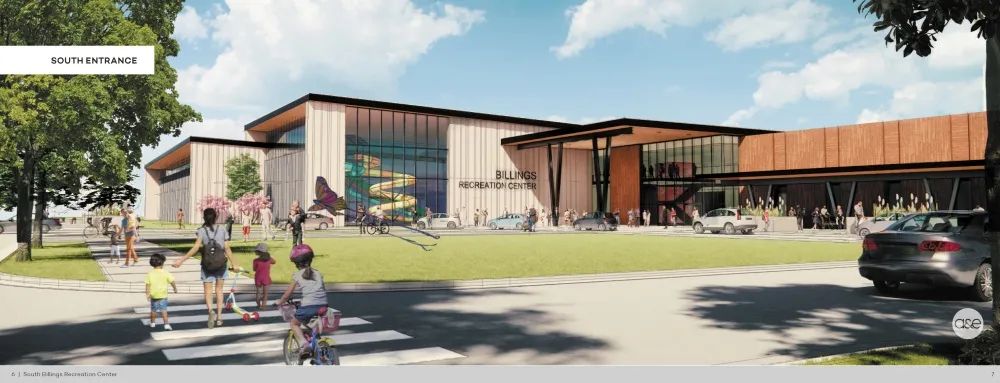
The Final Countdown: Billings Voters to Approve Multi-generational Sportsplex
November 2022
by stephanie hobby | Rendering(s) courtesy of Dusty Eaton, A&E Design
For years, the city has been working to address the need for a multi-generational, community-oriented Billings Community Recreation Center on the South Side, adjacent to Amend Park. After exhaustive surveys to assess residents’ needs, it was determined that the facility should include multi-use courts that could transition between basketball, volleyball, and pickleball, ice sheets for hockey, skating, and curling, an indoor walking, and jogging track, and a swimming pool big enough to host competitions, but also available for leisure swimming and swim lessons.
After collecting public input, the city council tasked A&E Design with creating the center, placing emphasis on building nontraditional spaces for gatherings and a competitive facility that could host regional sports tournaments to help drive the economy in Billings.
“It has to be a reflection of Billings and meet our community residents’ needs, but it also needs to be a facility that can support sports tourism. We could become a magnet for this region, to draw swim meets, basketball and volleyball, and hockey tournaments,” said Dusty Eaton, CEO and Principal of A&E Design. “There’s so much opportunity because there is no facility like this in the state of Montana. Really, between Williston and Spokane, we could be that real central point for drawing tournaments, swim meets, and competitive athletics to this location.”
So far, responses to surveys and listening sessions have been overwhelmingly supportive, and coordinators expect to finalize plans and take this to the voters sometime next year.
A significant portion of the new recreation center would be financed through a structure known as Tax Increment Financing or TIF. TIFs are state-authorized, locally driven funding mechanisms to help build or improve spaces identified by locally elected officials as Urban Renewal Districts, or URDs. URDs are typically characterized by stagnant or falling property tax values and a lack of infrastructure or growth.
With development, surrounding property values naturally rise, subsequently increasing tax revenue. Under a TIF, the net increase, or increment, in taxable values is set aside to be invested in the URD. The city council could designate a portion of property tax dollars generated within the URD to help improve economic conditions within or connecting to a specified district.
In 2008, the city council identified the South Billings Urban Renewal District, where property values - and thus taxes - had plateaued, hampering growth and other public improvements.
Under a TIF, Dick Zier, president of the South Billings Urban Renewal Association, estimates that his district will have generated significant funds for the center. “We can bond probably $30 to $35 million and wouldn’t increase anybody’s taxes,” he said. “We can pay it from the revenue we’re already generating into the district.” Until plans are finalized, there is no hard number on the remaining balance, funded through a bond issue if passed.
When the world hit pause in 2020, the plans had to be revisited to ensure they still met community needs. Designers returned to the committee to confirm plans, and it was decided to conduct another community survey and community stakeholder meetings. The turnout was remarkable, and over the past year, the designers have diligently worked to understand how to best create a facility that represents Billings’ needs.
During the public input sessions, the desire to have something truly multi-generational kept being repeated. Residents wanted something where seniors could use multiple pickleball courts in the morning, which could convert to youth volleyball and basketball courts in the afternoon.
“As we worked through that, one of the other elements that became important to balance is that this facility has the potential to increase our sports tourism in Billings, which should not be overlooked,” said Eaton.
The public benefit is a critical component of ensuring the use of TIF funds. “The key is that when we spend our urban renewal or our tax increment dollars, there has to be a public connection,” said Jim Tevlin, consultant to the South Billings Urban Renewal Association. “This investment, in turn, will increase the increment. And over time, the original life of a tax increment district is 15 years, but most tax increment district bills will issue bonds.” Bonds can extend the life of the district; if the bonds have a 25-year life but the district has a 15-year cap, the life of that district lengthens by 10 years.
Tevlin used the example that if the tax increment could generate $3 million, but the project costs $10 million, the city will issue bonds, and the cash flow from the tax increment will service the bonds.
“It’ll give the South Side a real boost as far as economic development because we’re already seeing restaurants going in down there because they know we’re working on this. And then there are people buying up land to put in maybe more hotels and other businesses. It will just bring a lot of activity to the area,” Zier said. “The economic impact is unimaginable, how good it would be for Billings. The hotels, the restaurants, the gas stations, everything. It’ll be a regional attraction.”
If the city council approves the project, the proposal will be presented to voters, which would likely happen sometime next year.
Originally printed in the November 2022 issue of Simply Local Magazine
Never miss an issue, check out SLM's digital editions here!





